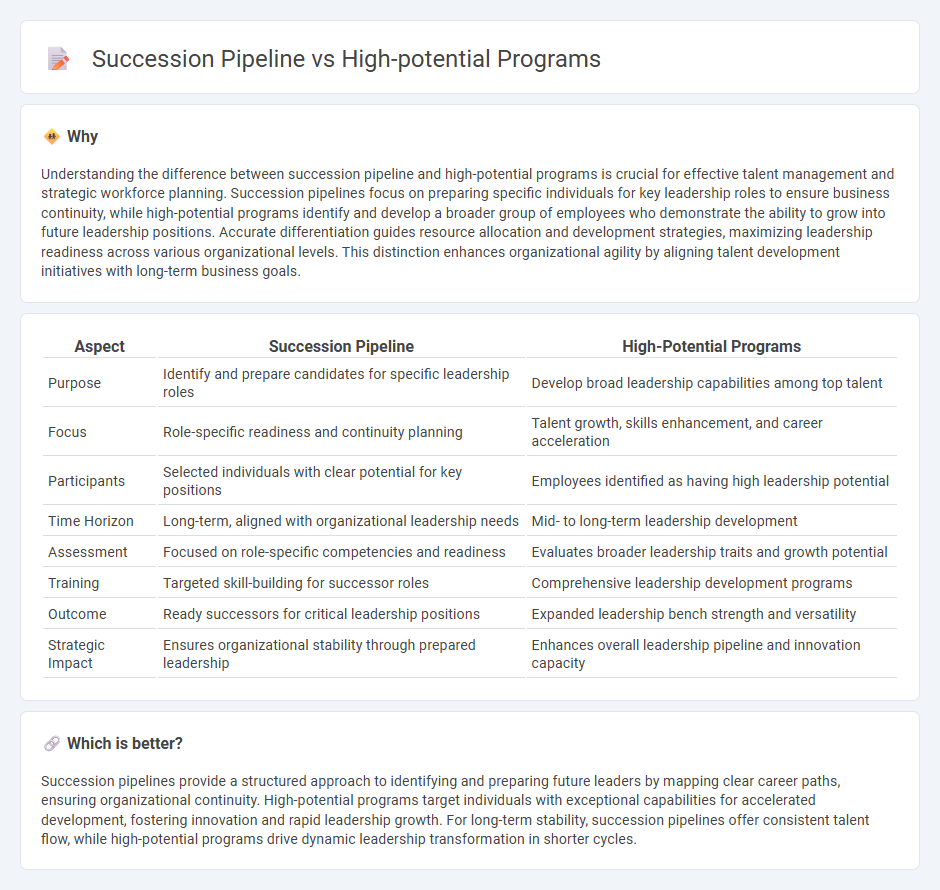
Succession pipeline programs focus on identifying and preparing specific candidates to fill key leadership roles, ensuring organizational continuity and stability. High-potential programs aim to develop a broader group of employees who demonstrate exceptional abilities and leadership potential for future advancement. Explore the differences and benefits of each approach to enhance your talent management strategy.
Why it is important
Understanding the difference between succession pipeline and high-potential programs is crucial for effective talent management and strategic workforce planning. Succession pipelines focus on preparing specific individuals for key leadership roles to ensure business continuity, while high-potential programs identify and develop a broader group of employees who demonstrate the ability to grow into future leadership positions. Accurate differentiation guides resource allocation and development strategies, maximizing leadership readiness across various organizational levels. This distinction enhances organizational agility by aligning talent development initiatives with long-term business goals.
Comparison Table
| Aspect | Succession Pipeline | High-Potential Programs |
|---|---|---|
| Purpose | Identify and prepare candidates for specific leadership roles | Develop broad leadership capabilities among top talent |
| Focus | Role-specific readiness and continuity planning | Talent growth, skills enhancement, and career acceleration |
| Participants | Selected individuals with clear potential for key positions | Employees identified as having high leadership potential |
| Time Horizon | Long-term, aligned with organizational leadership needs | Mid- to long-term leadership development |
| Assessment | Focused on role-specific competencies and readiness | Evaluates broader leadership traits and growth potential |
| Training | Targeted skill-building for successor roles | Comprehensive leadership development programs |
| Outcome | Ready successors for critical leadership positions | Expanded leadership bench strength and versatility |
| Strategic Impact | Ensures organizational stability through prepared leadership | Enhances overall leadership pipeline and innovation capacity |
Which is better?
Succession pipelines provide a structured approach to identifying and preparing future leaders by mapping clear career paths, ensuring organizational continuity. High-potential programs target individuals with exceptional capabilities for accelerated development, fostering innovation and rapid leadership growth. For long-term stability, succession pipelines offer consistent talent flow, while high-potential programs drive dynamic leadership transformation in shorter cycles.
Connection
Succession pipeline and high-potential programs are interconnected by identifying and developing talented individuals who exhibit strong leadership capabilities essential for future organizational roles. High-potential programs focus on accelerating skill growth and strategic insights, which strengthens the succession pipeline's ability to fill critical positions swiftly and effectively. Streamlined integration of these initiatives ensures sustained leadership continuity and operational excellence within the company.
Key Terms
Talent Identification
High-potential programs target employees with exceptional performance and leadership capabilities to prepare them for key roles, while succession pipelines strategically map out talent progressions ensuring business continuity. Effective talent identification involves assessing skills, performance metrics, and leadership potential to align individuals with future organizational needs. Explore advanced methods for talent identification to optimize your succession planning and high-potential initiatives.
Leadership Development
High-potential programs are designed to rapidly accelerate the growth of employees identified for future leadership roles, emphasizing skill enhancement and strategic thinking. Succession pipelines ensure a continuous flow of qualified candidates ready to fill key leadership positions, focusing on long-term organizational stability and readiness. Explore effective strategies to integrate both approaches for comprehensive leadership development.
Critical Roles
High-potential programs target individuals with exceptional leadership capabilities across the organization, enhancing overall talent readiness, while succession pipelines specifically focus on identifying and preparing candidates for critical roles vital to business continuity. Critical roles often require tailored development paths and strategic workforce planning to ensure seamless transitions and minimize operational risks. Explore how integrating both approaches can strengthen your leadership bench and secure your company's future success.
Source and External Links
High Potential Programs Examples - Provides examples of high-potential programs, including workforce potential assessments, career development programs, and the 3E approach, highlighting their applicability in different industries.
Essential Components of a High Potential Development Program - Discusses the importance of high-potential programs in developing future leaders and top performers within organizations.
Explore High-Potential Programs for Leaders at All Levels - Outlines essential elements of high-potential programs, including stretch skills, peer connections, and personal insights, designed to support rapid leadership growth.
 dowidth.com
dowidth.com